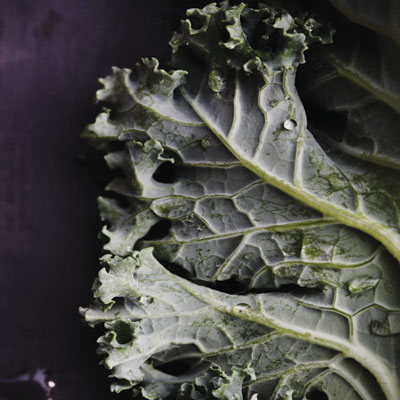New Ways to Cook with Kale
In all its forms, kale is one handsome vegetable. The dark green pebbly spears of Tuscan kale, the blushed red ribs of red Russian kale, the impossible frills of green kale and the sparkling brashness of purple kale stacked at farm stands and spilling out from the vegetable bins at Whole Foods has always appealed to the artist in me. The odd blue-greens and yellow-greens of the leaves, the tight sawtooth ruffles, the rosette shapes and variegated colors make kale a welcome addition to the garden, too.
Kale delivers great taste with lots of nutrition and high value for your food dollar, so why isn’t kale on everyone’s plate? For me, the remembered bitter taste, vile smell and mushy texture of the overcooked kale of my childhood kept me from exploring this great vegetable. My grandmother, an otherwise brilliant cook, boiled the greens nearly dead, then served them with new potatoes, cottage ham and cornbread to sop up the pot liquor. Not my favorite meal.
Talking with farmers I trust at markets convinced me to try kale and that beyond its impressive nutrition stats and incredible good looks, kale tastes good, too. They are right. The slightly nutty, milder flavor and mouth-tickling bite of fresh Tuscan, purple and standard green kale surprised guests at my recent kale tasting dinner. But no one was more astounded than me to discover the great taste of kale done right.
Farmer Jeremy Saurage of Deep Mud Farm grew Tuscan kale in hoop houses for the late winter farmers’ markets. “It’s the only kale I grow now,” Saurage said. “It tastes mild raw. You can throw some in any soup. I’ve cut it in ribbons, sautéed it and dressed it with vinegar to serve with kielbasa, like a sauerkraut.” Also known as Lacianato, Cavalo Nero, black or dinasaur kale, this sweeter variety makes terrific salads. Find it this spring at the Maplewood Farmers’ Market.
Cut to a lacy chiffonade, the lanky leaves, young and tender from Deep Mud, made a sprightly base for blanched asparagus and snap pea pods. Dress these spring favorites simply with lemon juice, zest, olive oil and shaved Parmagiano-Reggiano. In his cookbook Farm to Fork, Emeril Lagasse suggested a version of this salad using baby red Russian kale. We tasters gave five stars to his Tuscan kale and white bean ragout as well.
Tim Hess of Silent Oaks Farm will offer fully grown red Russian kale at the Clayton and Tower Grovemarkets. With its deeply cut, lacy leaves and blushed red ribs and veins, it’s a stunner. He’s sold the standard bluish-green frilled Winterbor for many years, but he’s adding red Russian and the milder Tostano, a variety of Tuscan kale, in response to customer requests.
Because my previous experiments with kale hadn’t gone well, I dug into the cookbooks to find the processes, timing and flavor pairings that would improve my dishes. Fast, Fresh and Green, a new cookbook by Susie Middleton, put me in the zone.
Her two-step process for greens had me wondering, but once I tried her approach, my sour experiences turned sweet. Middleton advocates boiling, which seems so harsh, but finding the timing for each variety of kale made for a tender bite without the undercooked rubbery feel or the overcooked spinelessness I’d dreaded as a child.
Middleton suggests pairing kale’s nutty, earthy flavor with the sweetness of caramelized onions or shallots. Try curries, too, or ginger-sesame sauces. Sweet-hot chile sauces stand up to the assertiveness of kale just fine.
My tasters gave me the best take-away message for trying kale cooked right: “I didn’t know I liked kale.” Me either. Try it and see.
Tags : Recipes






